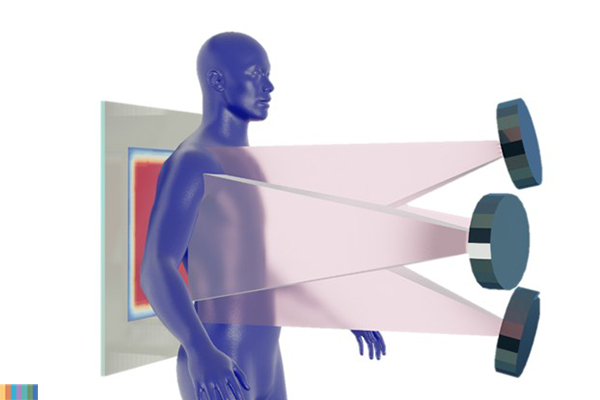
Researchers from the University of Liverpool’s QUASAR Group, including LIV.INNO fellow Dr Alexander Hill and 4th Year LIV.INNO PhD student Lauryn Eley, have published a major development in their pursuit of portable, low-dose 3D X-ray imaging. The study, “SCIMITAR: Optimising Chest Digital Tomosynthesis Devices Using Geometric Simulations and Genetic Algorithms”, led by Dr Hill and recently published in Biomedical Physics & Engineering Express, presents a powerful new framework for optimising digital tomosynthesis (DT) systems using computational modelling and data-driven optimisation.
The work marks a significant milestone within the OptiX project, a £400k initiative funded in 2024 by the Science and Technology Facilities Council (STFC) under UKRI’s Late-Stage Commercialisation Scheme. OptiX aims to deliver advanced 3D chest imaging directly at the patient’s bedside through Flat-Panel Source (FPS) technology, a novel approach developed in collaboration with Oxford-based company Adaptix Ltd.
Unlike conventional CT systems, which rely on mechanical movement and relatively high radiation doses, FPS technology uses electronically controlled X-ray emitters embedded within a stationary panel. This enables rapid 3D image acquisition in a compact, low-cost device, a potential game-changer for medical diagnostics in both hospital and community settings.
To bring this vision closer to reality, the SCIMITAR framework (Simulating Complete Irradiation Maps and Improving Tomosynthesis in X-ray Radiography) was developed to virtually design and optimise FPS-based imaging systems. Built on VTK-based geometric simulations and guided by a genetic algorithm, SCIMITAR models how X-ray beams interact with the patient and detector to generate irradiation maps, which are then optimised for coverage uniformity and dose efficiency.
This approach allows researchers to explore and refine array geometries far more efficiently than traditional experimental methods, reducing development costs and accelerating progress toward a clinically viable device. Importantly, SCIMITAR provides a generalisable platform that can support future system design guided by improved optimisation criteria and external design considerations.
Dr Hill explains: “This work wouldn’t be possible without the excellent collaboration and diversity of skills we have within the QUASAR group, as well as with our partners in industry. There’s more work to be done; however, SCIMITAR is a promising step towards the development of a transformational low cost and low dose 3D X-ray imaging device. With our LIV.INNO PhD student, Lauryn Eley, currently working on-site at Adaptix, our simulations and experimental campaigns are quickly reaching maturity. It’s a very exciting time for the project!”
The paper reflects the latest achievement in a decade-long collaboration between Adaptix Ltd and the QUASAR Group, supported by the LIV.DAT and LIV.INNO Centres for Doctoral Training. Together, these programmes have fostered a unique environment for training researchers at the interface of physics, data science, and cross-sector applications.
With SCIMITAR now providing a validated computational foundation, the OptiX team will continue to validate the design through experiments using synthetic anatomical phantoms and more sophisticated simulations. The long-term goal remains clear: to deliver a clinically deployable 3D X-ray imaging solution that is safer, faster, and more accessible than ever before.